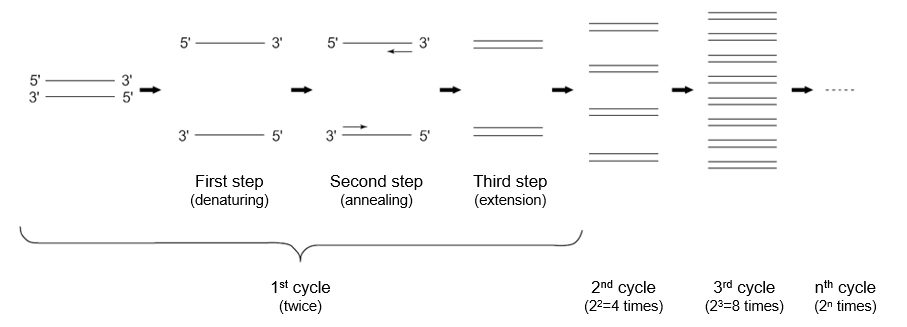PCR Reagents
The remarkable developments in the field of life science since the end of the 20 century have been supported by PCR technology, and Dr. Kary Mullis, the inventor of PCR technology, was awarded the Nobel Prize in Chemistry in 1993. The performance of PCR mainly depends on enzymes and buffer conditions, and companies are competing in areas related to the performance of PCR technology. Fujifilm Wako provides high-performance PCR reagents that are based on high-performance PCR enzymes and optimal buffer conditions.
Product Line-up
More Information
Principles of PCR
PCR (Polymerase Chain Reaction) is a method to amplify DNA by chain reactions using DNA polymerase.
The principle of PCR is to amplify target DNA 2n times by repeating 3 steps of temperature change for n cycles mainly using (1) DNA to be amplified, (2) a pair of DNA primers complementary to the sequences at both ends of the target DNA, and (3) thermostable DNA polymerase. At the first step of the temperature change (94 to 96°C), the target double-stranded DNA is heat-denatured to make it single strand; at the second step (55 to 60°C), the primers are annealed to the single-stranded DNA; and at the third step (72 to 74°C), the extension reaction proceeds. The amount of target DNA doubles in each cycle, and theoretically the target DNA is amplified 2n times after n cycles of reaction, so it will become amplified approximately 1 million times after 20 cycles (Figure).

Factors Influencing PCR
Factors that influence PCR performed using common Taq DNA polymerase are provided below.
Enzyme concentration
Taq DNA polymerase is usually used in a reaction solution at 1 to 2.5 units/100 μL. Generally, nonspecific products may be amplified when the concentration is too high, whereas amplification is suboptimal when the concentration is too low.
dNTP concentration
Generally, dNTP concentration is usually 20-200 μmol/L for each type. If the concentration of each type of dNTP used is not the same, an error will occur by incorrect incorporation. The lower the dNTP concentration, the higher the specificity and fidelity. Theoretically, when 20 μmol/L of each dNTP type is present in 100 μL reaction mixture, 2.6 μg of DNA can be synthesized.
Mg2+ concentration
Mg2+ is usually used at a concentration 0.5 to 2.5 mmol/L higher than the total dNTP concentration. Attention should be paid to the concentration of chelating agents such as EDTA, which are brought in from template DNA and primers.
Primers
Primers are usually designed to be 18 to 28 nucleotides long, to have a GC content of 50% to 60%, and to have a Tm value of 55 to 80°C. Two primers will be used, both at 0.1 to 0.5 μmol/L each.
Key design points for the primers are as follows:
- Tm values of both primers are similar.
- The nucleotide sequence at the 3' end of the primers is accurate.
- The 3' ends of the primers are not complementary to each other.
- GC content is not very high (50 to 60% is good). Specifically, the 3' end of the primers should not contain a GC-rich region.
- The primers themselves do not form a higher-order structure such as a hairpin.
Temperature
The higher the denaturation temperature, the higher the specificity and degree of amplification. However, high denaturation temperatures promote the reduction of Taq DNA polymerase activity; therefore, denaturation is usually performed at 94 to 96°C for about 15 to 30 seconds.
The annealing temperature of the primers is recommended to be about 5°C lower than the Tm value, and usually in the range of 55 to 60°C. The higher the annealing temperature, the higher the specificity. A primer of 0.2 μmol/L is annealed in a few seconds. The elongation temperature of 72°C is commonly used. The rate of synthesis is 35 to 100 nucleotides per second, but it may be changed by other reaction conditions.
Number of cycles
The higher the number of cycles, the higher the degree of amplification. However, higher numbers of cycles increase nonspecific products. The number of cycles is desirable to be not over 40. Theoretically, the amplification could be exponential, but in actual practice PCR amplification reaches a plateau phase.
Others
pH also influences PCR. Usually, 10 to 50 mmol/L Tris-HCl (pH 8.3 to 8.8 at 20°C) is used. Salt concentration, the presence of gelatin, and non-ionic surfactants also affect PCR. As the PCR reaction occurs at a very high temperature, the water in the reaction mixture may evaporate and the composition may change. Water evaporation can be prevented by superimposing mineral oil on the reaction solution. (Mineral oil is not required for some types of thermal cyclers.)
For research use or further manufacturing use only. Not for use in diagnostic procedures.
Product content may differ from the actual image due to minor specification changes etc.
If the revision of product standards and packaging standards has been made, there is a case where the actual product specifications and images are different.
The prices are list prices in Japan.Please contact your local distributor for your retail price in your region.



